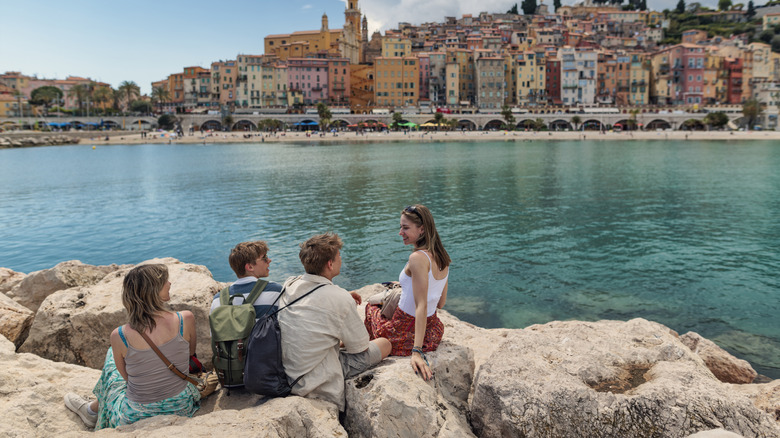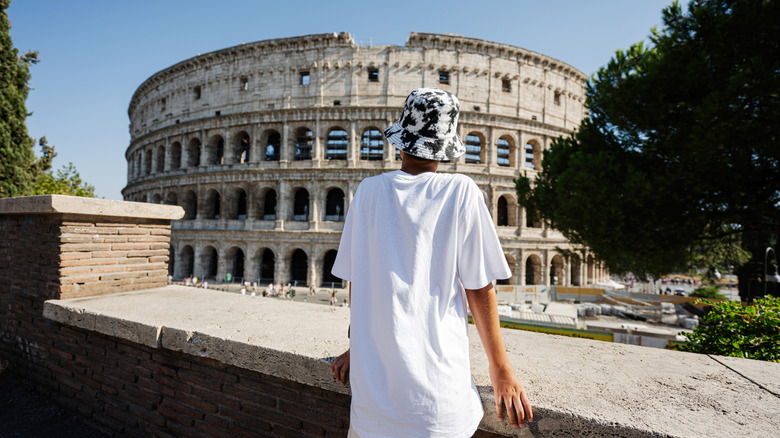Rick Steves Shared A Secret On How Younger Travelers Can Make The Most Of A Trip To Europe
Many young travelers might fixate on things like packing lists, Instagram-able landmarks, and trying to check as many things off a bucket list as possible, but the most meaningful parts of a trip often come unplanned. For Rick Steves, who first traveled to Europe at 14 years old, travel is one of the most important ways for younger people to expand their worldview, so long as they let it do so. "[F]or young adults new to travel, a trip abroad is eye-opening exposure to a broader world — a shifting of perspective that can feel like an emotional earthquake," Steves said in The Everett Herald.
Steves emphasizes a key difference between tourism and travel: While tourists have a more superficial, highly curated itinerary, travelers aim to immerse themselves in a place different from what they're used to. In short, travel should be more about perspective than sightseeing. This is especially important for younger travelers, who are in the first stages of breaking out of their comfort zone and in the midst of developing their unique perspective of the world. "When you come from a large and powerful country, it's easy to think your way is the norm," Steves shared. "But on my first trip to Europe with my parents as a 14-year-old, I discovered that travel is a crowbar, and my hometown perspective was its target." If you open yourself to the diversity of history and humanity, it can shatter your worldview in the best possible way.
As a young traveler, let the experience challenge your perspective
Rick Steves' metaphor of travel as a "crowbar" is a key to understanding his travel philosophy for young travelers: It should force open the limits of what you thought you knew. Reflecting on his travels along the Hippie Trail, which connected from Europe to South Asia, when he was 23 years old, Steves told Travel + Leisure that the biggest takeaway was "coming of age and getting away from home without a safety net and seeing the world, traveling with abandon." With this in mind, young travelers should embrace the sometimes unpredictable or even shocking nature of travel, rather than shy away from anything that veers off the path of the tourist checklist.
When it comes to experiencing other cultures, Steves shared with the outlet, "You have to be a cultural chameleon, and you have to work to go home with the most beautiful souvenir." One simple way to do this — and the tip that Steves says truly makes a good traveler — is to meet locals. This is where you break away from the tunnel vision of a mere tourist and get a lens into the true ways of life in another place. The travel guru recalled a few experiences with locals he met in Europe in The Everett Herald, such as "Austrian villagers eating bread spread with lard." Something as simple as eating with locals and trying their cuisine can give a whole new dimension to your travel experience, inviting conversation and a sense of connection you'd miss in a typical tourist restaurant.
How to sightsee with purpose
Immersing yourself in a new culture doesn't mean you need to skip Europe's iconic sites, from the Eiffel Tower to the Colosseum. They're popular for a reason, and Rick Steves himself recommends many free activities in Europe's big cities that may feel a bit like bucket list clichés. The key, according to Steves' philosophy, is to experience them intentionally: "Don't burn out on mediocre castles, palaces, and museums. Sightsee selectively," he said on his website. For young travelers especially, many of these places are first-time experiences. That "wow" factor is real, but Steves would say that the true worldview expansion comes from pausing to ask why it's so impressive. "When you understand the context in which things were made, who paid for it and why, what the challenges of the day were, and so on, paintings and statues become the closest thing Europe has to a time machine," he wrote.
It's also important to prioritize things that actually matter for younger travelers. Steves reflected on traveling with his own teens in The Everett Herald: "Turns out most teens couldn't care less about where Paul McCartney went to grade school. But they were more enthusiastic about the 'Bizarre Bath' walking tour in the English spa town of Bath." Younger travelers are still discovering what's most meaningful to them. They might find themselves more drawn to the street art of the cool French neighborhood Notre-Dame-du-Mont than the Notre-Dame Cathedral in Paris, and that's valid. Focusing on what's most engaging to you sparks a deeper connection and can serve as a gateway into discovering newfound interests.


